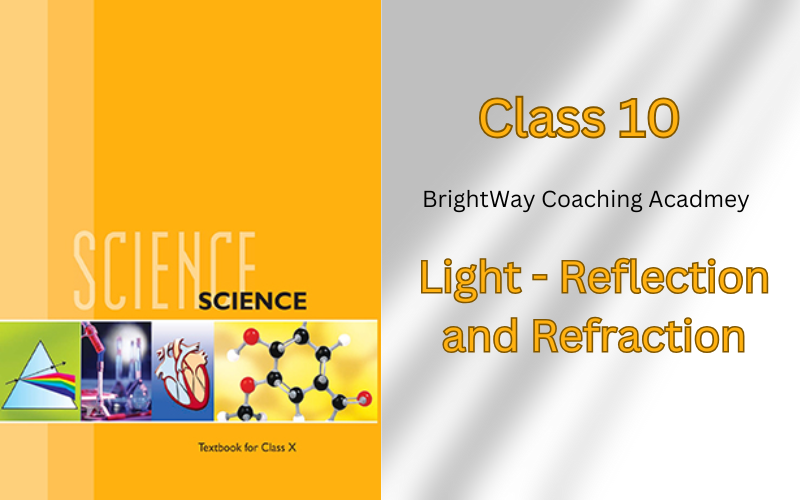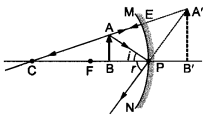Class 10 Chapter 9 Science Light – Reflection and Refraction

Page No. 142 — NCERT Solution of Class 10 Light – Reflection and Refraction
Question 1:
Define the principal focus of a concave mirror.
Answer
A number of rays parallel to the principal axis are falling on a concave mirror. They are all meeting/intersecting at a point on the principal axis of the mirror. This point is called the principal focus of the concave mirror.
Question 2:
The radius of curvature of a spherical mirror is 20 cm. What is its focal length?
Answer
Focal Length = ½ Radius of curvature = ½ * 20 cm = 10 cm.
Question 3:
Name a mirror that can give an erect and enlarged image of an object.
Answer
A concave mirror that can give an erect and enlarged image of an object.
Question 4:
Why do we prefer a convex mirror as a rear-view mirror in vehicles?
Answer
Convex mirrors are commonly used as rear-view (wing) mirrors in vehicles.
- These mirrors are fitted on the sides of the vehicle, enabling the driver to see traffic behind him/her to facilitate safe driving.
- Convex mirrors are preferred because they always give an erect, though diminished, image. Also, they have a wider field of view as they are curved outwards.
NCERT Solution of Class 10 Light – Reflection and Refraction
Page No. 145 – NCERT Solution of Class 10 Light – Reflection and Refraction
Question 1:
Find the focal length of a convex mirror whose radius of curvature is 32 cm.
Answer
Focal Length = ½ Radius of curvature = ½ 32 cm = 16 cm.
Question 2:
A concave mirror produces three times magnified (enlarged) real image of an object placed at 10 cm in front of it. Where is the image located?
Answer
Magnification is to be taken as negative for real images.
Magnification (m) = – 3
But u = – 10 cm
Here, the negative sign indicates that an inverted image is formed at a distance of 30 cm in front of the given concave mirror.
NCERT Solution of Class 10 Light – Reflection and Refraction
Page No. 150 – NCERT Solution of Class 10 Light – Reflection and Refraction
Question 1:
A ray of light travelling in air enters obliquely into water. Does the light ray bend towards the normal or away from the normal? Why?
Answer
A ray of light travelling from a rarer medium to a denser medium slows down and bends towards the normal.
Question 2:
Light enters from air to glass having refractive index 1.50. What is the speed of light in the glass? The speed of light in vacuum is 3 × 108 m s–1.
Answer
The refractive index of glass = 1.50
Speed of light in vacuum is 3 × 108 m s–1
Question 3:
Find out, from Table 9.3, the medium having highest optical density. Also find the medium with lowest optical density.
Answer
From table 9.3, diamond has highest refractive index (= 2.42), so it has the highest optical density.
Air has lowest refractive index (= 1.0003), so it has lowest optical density.
Question 4: You are given kerosene, turpentine and water. In which of these does the light travel fastest? Use the information given in Table 9.3.
Answer
For kerosene, n = 1.44
For turpentine, n = 1.47
For water, n = 1.33
As the refractive index of water is least out of three substances, the speed of light is maximum in water. So, light travels fastest in water.
Question 5:
The refractive index of diamond is 2.42. What is the meaning of this statement?
Answer
It means that speed of light in diamond is 2.42 times slower than speed of light in air.
NCERT Solution of Class 10 Light – Reflection and Refraction
Page No. 158
Question 1: NCERT Solution of Class 10 Light – Reflection and Refraction
Define 1 dioptre of power of a lens.
Answer
The SI unit of power of a lens is ‘dioptre’. It is denoted by the letter D. If f is expressed in metres, then, power is expressed in dioptres. Thus, 1 dioptre is the power of a lens whose focal length is 1 metre. 1D = 1m–1.
Question 2:
A convex lens forms a real and inverted image of a needle at a distance of 50 cm from it. Where is the needle placed in front of the convex lens if the image is equal to the size of the object? Also, find the power of the lens.
Answer
We are given that, Image-distance (v) = + 50 cm
If the image is equal to the size of the object, objejct-distance (u) = – 50 cm
Lens Formula,
Power of the lens
Question 3:
Find the power of a concave lens of focal length 2 m.
Answer
The focal length of a concave lens (f) = – 2 m (because focal length of a concave lens is negative)
Power of lens
NCERT Solution of Class 10 Light – Reflection and Refraction
Page No. 159 NCERT Solution of Class 10 Light – Reflection and Refraction
Exercise
Question 1:
Which one of the following materials cannot be used to make a lens?
(a) Water (b) Glass (c) Plastic (d) Clay
Answer
(d) Glay
Question 2:
The image formed by a concave mirror is observed to be virtual, erect and larger than the object. Where should be the position of the object?
(a) Between the principal focus and the centre of curvature
(b) At the centre of curvature
(c) Beyond the centre of curvature
(d) Between the pole of the mirror and its principal focus.
Answer
(d) Between the pole of the mirror and its principal focus.
Question 3:
Where should an object be placed in front of a convex lens to get a real image of the size of the object?
(a) At the principal focus of the lens
(b) At twice the focal length
(c) At infinity
(d) Between the optical centre of the lens and its principal focus.
Answer
(b) At twice the focal length
Question 4:
A spherical mirror and a thin spherical lens have each a focal length of –15 cm. The mirror and the lens are likely to be
(a) both concave.
(b) both convex.
(c) the mirror is concave and the lens is convex.
(d) the mirror is convex, but the lens is concave.
Answer
(a) both concave
Question 5:
No matter how far you stand from a mirror, your image appears erect. The mirror is likely to be
(a) only plane.
(b) only concave.
(c) only convex.
(d) either plane or convex.
Answer
(d) either plane or convex
Question 6:
Which of the following lenses would you prefer to use while reading small letters found in a dictionary?
(a) A convex lens of focal length 50 cm.
(b) A concave lens of focal length 50 cm.
(c) A convex lens of focal length 5 cm.
(d) A concave lens of focal length 5 cm.
Answer
(c) A concave lens of focal length 5 cm.
NCERT Solution of Class 10 Light – Reflection and Refraction
Question 7:
We wish to obtain an erect image of an object, using a concave mirror of focal length 15 cm. What should be the range of distance of the object from the mirror? What is the nature of the image? Is the image larger or smaller than the object? Draw a ray diagram to show the image formation in this case.
Answer
A concave mirror gives an erect image when the object is placed between the focus F and the pole P of the concave mirror, i.e., between 0 and 15 cm from the mirror. The image thus formed will be virtual, erect and larger than the object.

Question 8:
Name the type of mirror used in the following situations.
(a) Headlights of a car.
(b) Side/rear-view mirror of a vehicle.
(c) Solar furnace.
Support your answer with reason.
Answer
(a) Concave mirrors are used as reflectors in headlights of cars. When a bulb is located at the focus of the concave mirror, the light rays after reflection from the mirror travel over a large distance as a parallel beam of high intensity.
(b) A convex mirror is used as a side/rear-view mirror of a vehicle because
(i) A convex mirror always forms an erect, virtual and diminished image of an object placed anywhere in front it.
(ii) A convex mirror has a wider field of view than a plane mirror of the same size.
(c) Large concave mirrors are used to concentrate sunlight to produce heat in solar furnaces.
Question 9:
One-half of a convex lens is covered with a black paper. Will this lens produce a complete image of the object? Verify your answer experimentally. Explain your observations.
Answer
Yes, one-half of a convex lens when covered with a black paper, the lens produces a complete or full image of an object.
To verify experimentally:
Take a convex lens, cover half part of it as shown in the figure, with a paper. Place it on a stand.
Focus a distant object on a screen, the image obtained on the screen is complete.
Observation and conclusion: Image formed on the screen does not depend on the size of the lens. The brightness of the image decreases as less number of rays pass through the lens.
Question 10:
An object 5 cm in length is held 25 cm away from a converging lens of focal length 10 cm. Draw the ray diagram and find the position, size and the nature of the image formed.
Answer

Hence, the image formed at 16.67 cm from the lens on the other side. The size of the image is 3.3 cm, i.e., reduced and inverted.
Question 11:
A concave lens of focal length 15 cm forms an image 10 cm from the lens. How far is the object placed from the lens? Draw the ray diagram.
Answer
Concave lens


Question 12:
An object is placed at a distance of 10 cm from a convex mirror of focal length 15 cm. Find the position and nature of the image.
Answer

The image is formed 6 cm behind the mirror, virtual image is formed.
Question 13:
The magnification produced by a plane mirror is +1. What does this mean?
Answer
Magnification, m = + 1
+ indicates virtual image.
1 indicates that the object size and image size is same.
Question 14:
An object 5.0 cm in length is placed at a distance of 20 cm in front of a convex mirror of radius of curvature 30 cm. Find the position of the image, its nature and size.
Answer


NCERT Solution of Class 10 Light – Reflection and Refraction
Question 15:
An object of size 7.0 cm is placed at 27 cm in front of a concave mirror of focal length 18 cm. At what distance from the mirror should a screen be placed, so that a sharp focussed image can be obtained? Find the size and the nature of the image.
Answer
Concave minor
u = – 27 cm, f = -18 cm, h = 7.0 cm
Question 16:
Find the focal length of a lens of power – 2.0 D. What type of lens is this?
Answer
P = – 2.0 D
NCERT Solution of Class 10 Light – Reflection and Refraction
Question 17:
A doctor has prescribed a corrective lens of power +1.5 D. Find the focal length of the lens. Is the prescribed lens diverging or converging?
Answer

Power of the lens is +ve, and it is converging lens i.e., convex lens.
NCERT Solution of Class 10 Light – Reflection and Refraction

